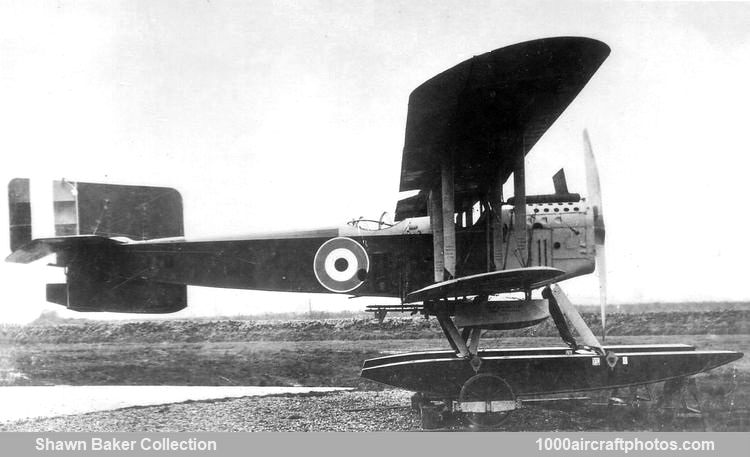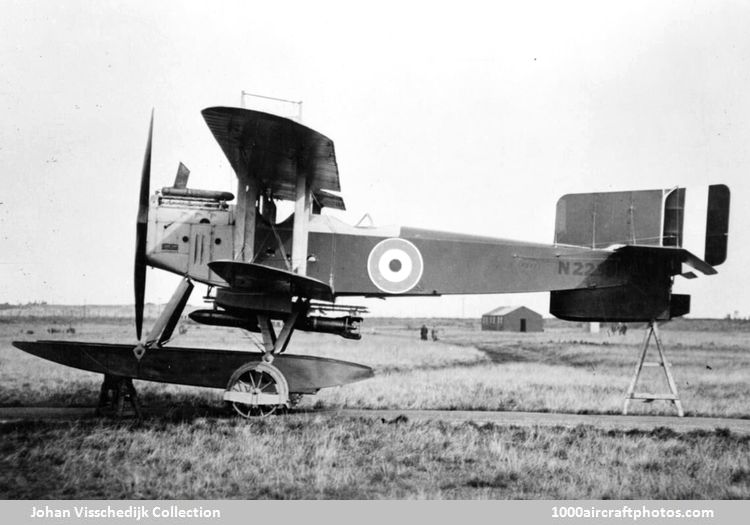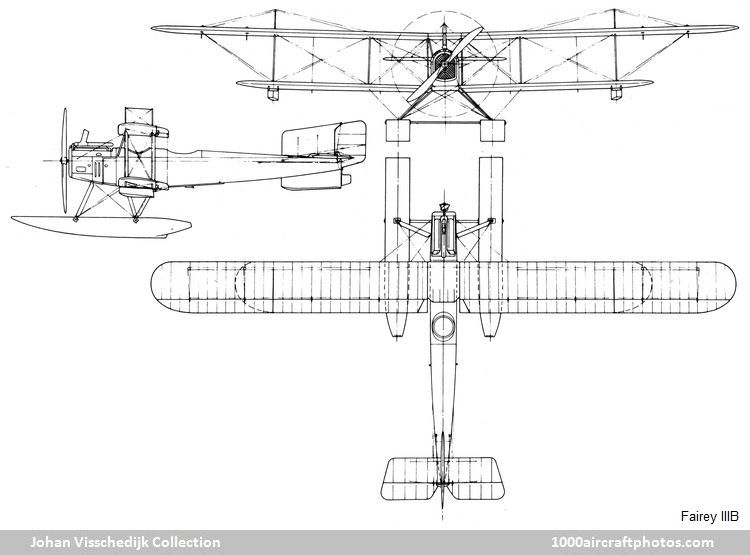APS No. 3597

12/31/2024. Remarks by Johan Visschedijk: "The well-known Fairey III Series were preceded by two different seaplanes designed and built in parallel in 1917 to meet the Admiralty Specifications N.2(a), for a two-seat aircraft for reconnaissance operations from seaplane carriers, and N.2(b) for a two-seat seaplane designed specifically for bombing duties. They were serialed N9 (c/n F.127) and N10 (c/n F.128).
Towards the end of 1917 the N10 serialed aircraft, which was justifiably described as the prototype of the III Series, had been modified to operate as a landplane, with a straightforward V-strut undercarriage replacing the floats, and was given the designation IIIA. This version went into production as a shipborne two-seat bomber with an order for fifty for the Royal Naval Air Service, which was then about to be merged with the Royal Flying Corps to form the Royal Air Force.
The IIIA retained the 260 hp Sunbeam Maori II twelve-cylinder liquid-cooled V-engine, as used on the N10, but was naturally faster than its floatplane original. It was armed with a single Lewis gun on a Scarff ring for the observer and could carry bombs in external racks under the fuselage. The IIIA was intended as a replacement for the obsolescent Sopwith 1½-Strutters operating with the RNAS. Production started in 1918 with N2850 (c/n F.220) and ended with N2899 (c/n F.269). The first IIIA was flown by Lt.-Col. G.L.P. Henderson at Northolt on June 6, 1918.
The Armistice overtook the IIIA and the type saw little if any active service; all appear to have been declared obsolete in 1919. The type was variously fitted with normal wheel and plain skid undercarriages for carrier operations. Wheels were fitted to fourteen aircraft, N2850 to N2852 (c/n F.220 to F.222) and N2889 to N2899 (c/n F.259 to F.269). Skids were fitted to 35 aircraft, N2853 to N2862 (c/n F.223 to F.232) and N2864 to N2888 (c/n F.234 to F.258).
The remaining IIIA, N2863 (c/n F.233), was used for experiments with hydrofoils, or hydrovanes - as they were differently named at the time. These devices were fitted to the front of the undercarriages and designed to make landplane alightings on the sea more or less safe by preventing the aircraft from nosing-over on touchdown. Flotation gear was used to keep the aircraft buoyant until the pilot could be rescued and the aircraft (possibly) retrieved. The rigid skid undercarriage was one of the temporary methods used in the endeavor to find ways of keeping the aircraft straight during take offs from the short decks, and in developing effective arrester systems. Many experiments with skid undercarriages had previously been made with Sopwith 1 ½-Strutters and Pups. Hydrovanes and inflatable air bags, externally stowed, were to remain features of shipborne landplanes until the early 1920s.
The IIIB was another variant which went into small-scale production in time for a few to reach at least one seaplane station, Westgate-on-Sea, Kent, before the end of WW I. During a relatively short period in service it was used mainly for mine-spotting patrols. The IIIB was a two-seat seaplane designed specifically for bombing duties within the Admiralty N.2(b) requirements and had a fuselage and tail similar to those of the III and IIIA, but with increased wing, fin and rudder areas and with bigger main floats than the III. The two-bay folding wings had pronounced upper-wing overhangs which carried the ailerons. These extensions were braced from kingposts above the outer interplane struts. Camber-changing gear was fitted.
The IIIB was powered by the Maori II engine which, like that of the IIIA, had a frontal, or nose-type radiator. Armament consisted of a Lewis gun on a Scarf ring for the observer, with provision for bombs, up to a total weight of 600 lb (272 kg), in tubular carriers well below the fuselage. The first flight of the IIIB was made by Vincent Nicholl, from Hamble on August 8, 1918.
A shock-absorbent mounting for the floats was introduced for the IIIB. In those days the floats of seaplanes were, with a few exceptions, little more than lightweight pontoons made of wood frames covered with plywood. There was no chined keel, but the flat bottoms had ash runners to protect them from beaching damage and there was, in later versions, a shallow step aft. With the IIIB the floats were attached to the undercarriage structure by rubber cord to help to isolate the fuselage from the worst shocks during take off and alighting.
Serial numbers for sixty IIIBs were allotted, N2230 to N2259 (c/n F.277 to F.306) and N9230 to N9259 (c/n F.307 to F.336). However, N2233, N2246, N2255 to N2259 and N9230 to N9259 were converted on the line to IIICs, so in the end 23 IIIBs were built. Others in the series were later converted to the IIIC standard for civil operations."
Towards the end of 1917 the N10 serialed aircraft, which was justifiably described as the prototype of the III Series, had been modified to operate as a landplane, with a straightforward V-strut undercarriage replacing the floats, and was given the designation IIIA. This version went into production as a shipborne two-seat bomber with an order for fifty for the Royal Naval Air Service, which was then about to be merged with the Royal Flying Corps to form the Royal Air Force.
The IIIA retained the 260 hp Sunbeam Maori II twelve-cylinder liquid-cooled V-engine, as used on the N10, but was naturally faster than its floatplane original. It was armed with a single Lewis gun on a Scarff ring for the observer and could carry bombs in external racks under the fuselage. The IIIA was intended as a replacement for the obsolescent Sopwith 1½-Strutters operating with the RNAS. Production started in 1918 with N2850 (c/n F.220) and ended with N2899 (c/n F.269). The first IIIA was flown by Lt.-Col. G.L.P. Henderson at Northolt on June 6, 1918.
The Armistice overtook the IIIA and the type saw little if any active service; all appear to have been declared obsolete in 1919. The type was variously fitted with normal wheel and plain skid undercarriages for carrier operations. Wheels were fitted to fourteen aircraft, N2850 to N2852 (c/n F.220 to F.222) and N2889 to N2899 (c/n F.259 to F.269). Skids were fitted to 35 aircraft, N2853 to N2862 (c/n F.223 to F.232) and N2864 to N2888 (c/n F.234 to F.258).
The remaining IIIA, N2863 (c/n F.233), was used for experiments with hydrofoils, or hydrovanes - as they were differently named at the time. These devices were fitted to the front of the undercarriages and designed to make landplane alightings on the sea more or less safe by preventing the aircraft from nosing-over on touchdown. Flotation gear was used to keep the aircraft buoyant until the pilot could be rescued and the aircraft (possibly) retrieved. The rigid skid undercarriage was one of the temporary methods used in the endeavor to find ways of keeping the aircraft straight during take offs from the short decks, and in developing effective arrester systems. Many experiments with skid undercarriages had previously been made with Sopwith 1 ½-Strutters and Pups. Hydrovanes and inflatable air bags, externally stowed, were to remain features of shipborne landplanes until the early 1920s.
The IIIB was another variant which went into small-scale production in time for a few to reach at least one seaplane station, Westgate-on-Sea, Kent, before the end of WW I. During a relatively short period in service it was used mainly for mine-spotting patrols. The IIIB was a two-seat seaplane designed specifically for bombing duties within the Admiralty N.2(b) requirements and had a fuselage and tail similar to those of the III and IIIA, but with increased wing, fin and rudder areas and with bigger main floats than the III. The two-bay folding wings had pronounced upper-wing overhangs which carried the ailerons. These extensions were braced from kingposts above the outer interplane struts. Camber-changing gear was fitted.
The IIIB was powered by the Maori II engine which, like that of the IIIA, had a frontal, or nose-type radiator. Armament consisted of a Lewis gun on a Scarf ring for the observer, with provision for bombs, up to a total weight of 600 lb (272 kg), in tubular carriers well below the fuselage. The first flight of the IIIB was made by Vincent Nicholl, from Hamble on August 8, 1918.
A shock-absorbent mounting for the floats was introduced for the IIIB. In those days the floats of seaplanes were, with a few exceptions, little more than lightweight pontoons made of wood frames covered with plywood. There was no chined keel, but the flat bottoms had ash runners to protect them from beaching damage and there was, in later versions, a shallow step aft. With the IIIB the floats were attached to the undercarriage structure by rubber cord to help to isolate the fuselage from the worst shocks during take off and alighting.
Serial numbers for sixty IIIBs were allotted, N2230 to N2259 (c/n F.277 to F.306) and N9230 to N9259 (c/n F.307 to F.336). However, N2233, N2246, N2255 to N2259 and N9230 to N9259 were converted on the line to IIICs, so in the end 23 IIIBs were built. Others in the series were later converted to the IIIC standard for civil operations."


Created December 31, 2024